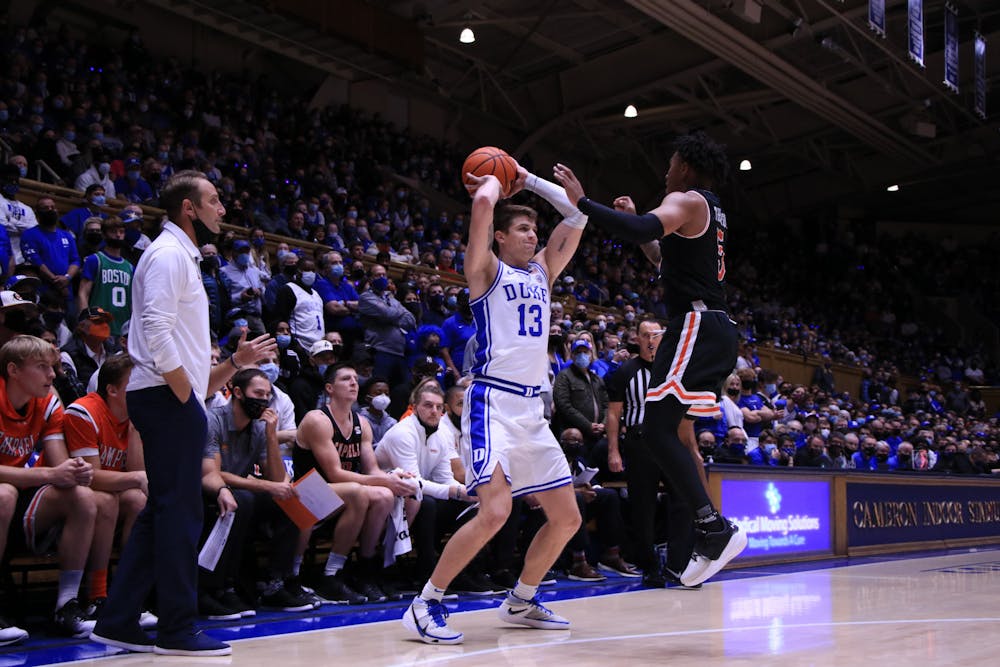In Duke’s latest duel, it was Campbell that made the first move. The Blue Devils then had to make the next move in the on-court chess game to dig themselves out of check.
Duke started the game with the same lineup it rolled out in wins against Kentucky and Army, but the combination of freshman Paolo Banchero paired with either Theo John or Mark Williams had Duke fans surprisingly biting their nails as the Fighting Campbells jumped out to a lead. Campbell utilized the same starters as last year—a successful squad of four or five guards with good shooting ability—and instantly exploited the bigger Duke lineup. Once down by ten points, head coach Mike Krzyzewski made the game-saving move to set Duke up for its 67-56 win, deciding to use Banchero with a handful of guards.
“We’ve faced veteran teams and different styles. This one with five guards. And most of the time, you just have five handlers,” Krzyzewski said.
Switching to small ball wasn't the plan heading into this one, Krzyzewski said, adding that the game plan "was like improvisation."
Without forward Wendell Moore Jr., returning from injury until seven minutes into the first half and desperate for support, Duke went with a lineup including AJ Griffin or Joey Baker alongside Banchero and either John or Williams. If Moore’s absence wasn’t enough of a concern, the 18-8 lead Campbell had at the 13:55 mark of the first half showed that change was needed.
The tallest player on Campbell’s starting lineup was 6-foot-8 Jesús Carralero—and even he sat for a while after collecting two fouls—leaving a small lineup that could distribute and shoot consistently. After Williams logged just six minutes for Duke in the first half, he stayed on the bench for the rest of the night. While this seemed like a curious decision considering how well he played at the end of last season, the first three games of the new year have indicated that Duke can live without the 7-footer if the game calls for it.
“We weren't able to see what a bigger lineup did with Wendell [on the floor]. And so it's not like our big guys weren’t playing. But they didn't have enough room to operate,” Krzyzewski said.
He added that “Theo really gave us a few good minutes, especially when guarding a guard, but also running some screens to get us open.”
So for those wondering what the issue is with Mark Williams, Krzyzewski still feels he has some work to do defensively, but those struggles mainly come through when trying to switch one through five. John’s presence noticeably had an impact during his 10 minutes of play, helping the motion offense thrive.
The next move in the improv act was the deployment of a much smaller Duke rotation—though still winning the size advantage—that allowed Duke to play a much smoother game on both ends of the court. The five players to log over 30 minutes were Jeremy Roach, Trevor Keels, Moore, Baker and Banchero. From about the 10-minute mark in the first half onward, Duke never had Banchero and a center on the floor at the same time.
The small lineup was more mobile and slowed a Campbell 3-point attack that started off the night 4-of-6. The Fighting Camels’ star Cedric Henderson Jr., only shot 1-of-5 from deep, and the team finished with a 6-for-23 clip including 0-for-8 in the second half. The smaller lineup did, however, allow Henderson to plunge deep inside and convert layups en route to an 18-point, 11-rebound night.
On the other side, the smaller lineup displayed a lot of stretched-out looks, with four potent shooters open for kick outs off of a dribble drive from an able passer—who, with that lineup, was about everyone. That led Duke to match Campbell’s shooting threat with a 3-point barrage of its own, and no one was more crucial to that as Baker.
“He hits threes, when it's a four-point lead, there's a lot of pressure. That's big,” Krzyzewski said of his senior captain.
Baker nailed three 3-pointers and tallied all of his 11 points during the second half alone, and his strong play Friday and Saturday night deservingly earned praise from his coach. The floor spacing issue resolves itself when the shooter's stroke is on—and Baker filled a much needed void with Trevor Keels’ shooting stroke still sorting itself out. The freshman has shot a meager 26.7% from deep, leaving Baker as a promising shooting option.
In its first week of the new season, Duke has seen a combination of teams that have allowed it to reveal its own weaknesses, and learn how to fix them, with the looming issues still rebounding and 3-point shooting. But the small-ball lineup may ultimately reveal a strength.
“This isn’t like you—’Okay now we're going to do this forever.’ Part of having a good season is being able to improvise, and have different lineups to combat the different systems that you play against,” Krzyzewski said.
So maybe the lineup he busted out tonight, which took a 10-point deficit into an 11-point lead, isn’t going to be a common combination. But if Duke has some rocky starts in its nonconference games, the Blue Devils know they can succeed through improvisation.
Get The Chronicle straight to your inbox
Signup for our weekly newsletter. Cancel at any time.
Micah Hurewitz is a Trinity senior and was previously a sports managing editor of The Chronicle's 118th volume.

